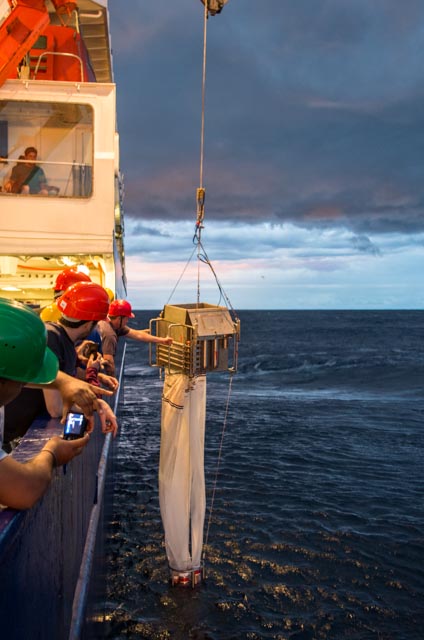Earlier this month Jens Weiser set out from southern Africa to find out more about the region’s biology and geology. Back aboard FS Meteor, he’s searching for layers of lagoonal muds to see what the climate was like here in the late Quaternary…
After quite a lot of transit, we arrived at our first big station off Durban on Wednesday afternoon. On our way here we used the time to introduce ourselves and our work to the rest of the group. Every participant had prepared a short talk about a recently finished project or his/her home institution. Since we all come from different parts of the world (South Africa, Germany, Kenya, Madagascar, Mauritius and Spain) and are involved in very different projects, these sessions were a nice opportunity to think outside the box for a while. I had for example never heard a talk on the ecology of fish larvae before, so meant that I could look at the environment from another perspective, rather than my usual geological approach.
We started our fieldwork with a CTD (Conductivity, Temperature, Density)-cast, as we will on every major stop from now on. The device is lowered down to a specific depth, constantly measuring the physical properties of the water. These will give a good insight into the architecture of the water mass and should correlate with the biological data too.
The biological work included plankton nets, multi nets and a ring trawl. The nets are used to retrieve plankton in various sizes and from varying depths, since the opening of the multi net can be opened and closed independently. As it is towed vertically back to the ship, different levels of the water column can be sampled. The ring trawl is towed while the vessel is moving and recovers plankton from the surface. During analysis, the biologist on board will focus on the fish larvae and copepods. As we are following the Agulhas Current to the South, changes in their age and abundance will give insight into the ecology of these organisms in this hydrologically dynamic region.

The multi net is lowered to a desired depth. On its way back to the surface it recovers plankton samples from varying intervals of the water column. (Credit: Jens Weiser)
The weather was far from perfect the entire night, but when we wanted to start the geological work just before sunrise the strong rain and winds of up to 8 on the Beaufort Scale made things really uncomfortable. Since the selected sites looked promising on the PARASOUND (sub-seafloor, high-resolution imaging) instrument, we wanted to try it anyway. Promising, in this case, means: a thin layer of coarse, sandy sediments overlying lagoonal muds – what we were searching for. The first device we tried was the gravity corer, which uses only a heavy weight to force the drill pipe into the sediment. This did not return a satisfying core though, even when we changed the position. So we switched to the Vibrocorer, which uses a vibrating engine and is more suitable for coarse-grained sediments. This worked much better and throughout the day we were able to recover three cores of that were 5 metres long. Unfortunately none of them reached the lagoonal sediments, which are the more useful paleoenvironmental archive. A more detailed investigation in the next few days will reveal whether we can use the sand and shell debris we have recovered anyway. Some of the biologist are interested in them as well – it’s a good thing we are on such a multidisciplinary cruise.

The Vibrocorer is prepared on deck. It is the lowered to the seafloor, where it can recover cores from coarse-grained sediments. (Credit: Jens Weiser)
By Jens Weiser, University of Bremen
Catch up on findings from the research cruise here.





Pingback: A dangerous fish in the lab and a Vibrocorer on the move – who said research was monotonous? | GeoLog